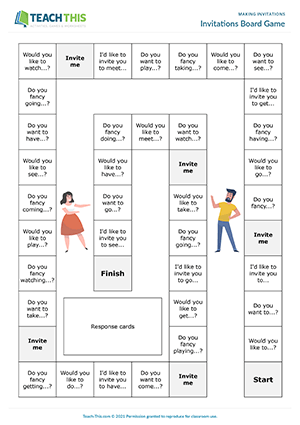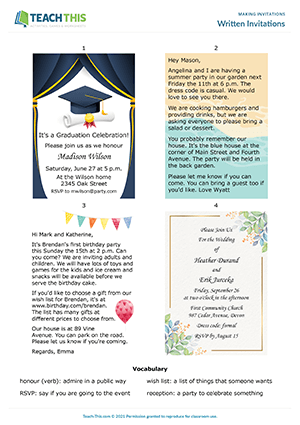In this communicative making invitations speaking activity, students make, accept and decline invitations and make suggestions on where and when to meet. The aim of the activity is to invite three other students to an event on a ticket and fill up a diary by accepting other students' invitations. Students walk around the class and invite other people to go with them to the event on their ticket. Students only accept an invitation if they really want to go and are free. If not, students decline the invitation and give an excuse. When a student accepts a classmate's invitation, the student writes the invitation in their diary and the classmate writes the student's name on the back of their ticket. After an invitation has been accepted, the two students suggest a time and place to meet. When everyone has finished, students give feedback to the class on who accepted their invitations and what plans they have in their diary.
In this productive making invitations activity, students practice phrases for inviting and making arrangements by putting sentences from a conversation in the correct order and then using the language to make new conversations. One student starts the conversation by looking at their sentences and reading the most suitable one to start the conversation. The student then puts number 1 next to the sentence. Their partner listens and looks for a suitable reply and then reads that reply, putting number 2 next to the sentence. This process continues until the conversation has been put in order from 1 to 14. After that, the pairs make two similar conversations using the language for inviting and making arrangements from the worksheet. When the students have finished, they present their conversations to the class.
In this free making and declining invitations game, students are invited to do various things and must try to decline each invitation with a unique excuse. In groups, students take it in turns to pick up a card and use the prompt on the card to invite the student on their right to do something, e.g. 'Do you want to go to the park this afternoon?' The student on their right then tries to win the card by declining the invitation and giving an excuse, e.g. 'I'm sorry, but I have to study English this afternoon'. If the student does this successfully, the other student gives them the card. Students are not allowed to use the same excuse twice during the game. If they do or they can't think of an excuse, the invitation passes to the next student on the right. This continues until a student comes up with a new reason and wins the card. The student with the most cards at the end of the game wins. Afterwards, there is a class feedback session to find out some of the best reasons for declining an invitation.
In this fun making invitations board game, students practice making and responding to invitations. Players take it in turns to roll the dice and move their counter along the board. When a player lands on a square, the student to their right invites the player to do something using the prompt on the square, e.g. 'Would you like to go to the cinema with me tomorrow afternoon?' The player then picks up a response card and uses the prompt on the card to reply to the invitation. The response either requires the player to decline the invitation and make an excuse or express a possibility to accept. The other students listen and judge the player's response. If the player responds appropriately, they stay on the square. If not, the player goes back two squares. The first player to reach the finish wins the game.
In this comprehensive making invitations worksheet, students practice language for making, accepting and declining spoken and written invitations. First, students read a conversation about a host inviting someone to her party and then answer comprehension questions about it. Next, students use their answers to complete a written invitation. After that, students categorize phrases for making, accepting and declining invitations and complete three short conversations with the language. In the last exercise, students create a party invitation and use it to practice inviting, accepting or declining with their classmates.
In this useful making invitations worksheet, students learn what goes in a written invitation and practice reading and writing invitations. Students start by writing down what details should be included in an invitation to a party for a friend. Students then read four invitations and match the invitations to events. Next, students identify what details are included in each invitation. After that, students write an email invitation to the party and read it to the class. Finally, students discuss which of the invitations from the worksheet are the most formal and the least formal and why, and which event they would like to go to.
Latest Free
Resources
- The Bus Stop
Getting Around (B1)
Date Added: 1st of October
- Study Skills Showdown
Study Skills (B2)
Date Added: 10th of September
- Everyday Objects Bingo
Everyday Objects (A1-A2)
Date Added: 25th of August
- Action Verb Races
Actions (A1-A2)
Date Added: 18th of August
- Birthday Basics
Birthdays (A1-A2)
Date Added: 8th of August
Latest Member
Resources
- Casual Greetings
Greetings and Introductions (B2)
Date Added: 22nd of October
- Identifying and Clarifying Problems
Dealing with Problems (B2)
Date Added: 22nd of October
- What if we tried...?
Dealing with Problems (B2)
Date Added: 22nd of October
- Suitable Excuses
Making Excuses (B2)
Date Added: 21st of October
- Superlatives Showdown
Superlatives (A1-A2)
Date Added: 21st of October









